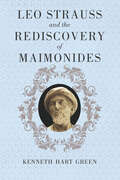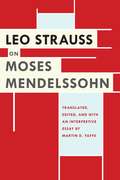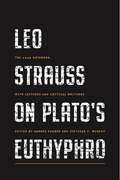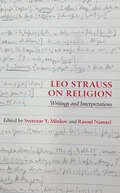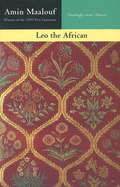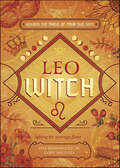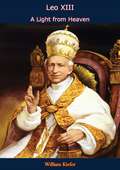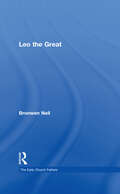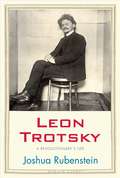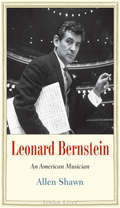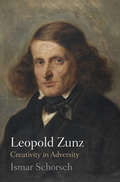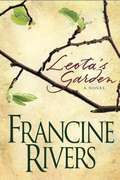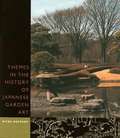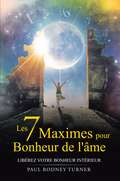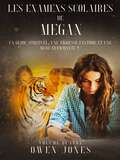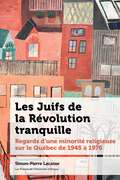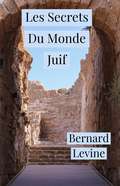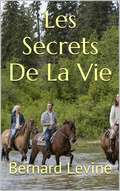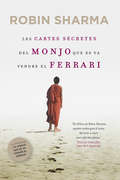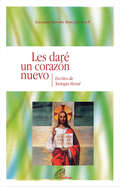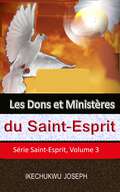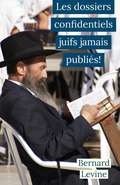- Table View
- List View
Leo Strauss and the Rediscovery of Maimonides
by Kenneth Hart GreenIn Leo Strauss and the Rediscovery of Maimonides, Kenneth Hart Green explores the critical role played by Maimonides in shaping Leo Strauss’s thought. In uncovering the esoteric tradition employed in Maimonides’s Guide of the Perplexed, Strauss made the radical realization that other ancient and medieval philosophers might be concealing their true thoughts through literary artifice. Maimonides and al-Farabi, he saw, allowed their message to be altered by dogmatic considerations only to the extent required by moral and political imperatives and were in fact avid advocates for enlightenment. Strauss also revealed Maimonides’s potential relevance to contemporary concerns, especially his paradoxical conviction that one must confront the conflict between reason and revelation rather than resolve it. An invaluable companion to Green’s comprehensive collection of Strauss’s writings on Maimonides, this volume shows how Strauss confronted the commonly accepted approaches to the medieval philosopher, resulting in both a new understanding of Maimonides and a new depth and direction for his own thought. It will be welcomed by anyone engaged with the work of either philosopher.
Leo Strauss on Moses Mendelssohn
by Leo StraussMoses Mendelssohn (1729–86) was the leading Jewish thinker of the German Enlightenment and the founder of modern Jewish philosophy. His writings, especially his attempt during the Pantheism Controversy to defend the philosophical legacies of Spinoza and Leibniz against F. H. Jacobi’s philosophy of faith, captured the attention of a young Leo Strauss and played a critical role in the development of his thought on one of the fundamental themes of his life’s work: the conflicting demands of reason and revelation. Leo Strauss on Moses Mendelssohn is a superbly annotated translation of ten introductions written by Strauss to a multi-volume critical edition of Mendelssohn’s work. Commissioned in Weimar Germany in the 1920s, the project was suppressed and nearly destroyed during Nazi rule and was not revived until the 1960s. In addition to Strauss’s introductions, Martin D. Yaffe has translated Strauss’s editorial remarks on each of the passages he annotates in Mendelssohn’s texts and brings those together with the introductions themselves. Yaffe has also contributed an extensive interpretive essay that both analyzes the introductions on their own terms and discusses what Strauss writes elsewhere about the broader themes broached in his Mendelssohn studies. Strauss’s critique of Mendelssohn represents one of the largest bodies of work by the young Strauss on a single thinker to be made available in English. It illuminates not only a formerly obscure phase in the emergence of his thought but also a critical moment in the history of the German Enlightenment.
Leo Strauss on Plato’s Euthyphro: The 1948 Notebook, with Lectures and Critical Writings
by Hannes Kerber and Svetozar Y. MinkovLeo Strauss famously asserted that the fundamental, defining debate within Western civilization is that between Jerusalem and Athens, piety and philosophy, the Bible and Plato. And yet, surprisingly, Strauss never published any of his thoughts on Plato’s dialogue on piety, the Euthyphro.This volume presents, for the first time, Strauss’s 1948 notebook on the dialogue, written in preparation for a class at the New School for Social Research. Featuring close analysis and line-by-line commentary, the notebook opens a window onto a philosophic mind in action, as Strauss asks questions of the classic text, jots down observations and formulations, and analyzes very specific terms and arguments but also steps back, reviews the overall movement of the dialogue, and reconsiders previous conclusions. Beyond the notebook, the volume also brings together all the known materials that lay out Strauss’s thoughts on the Euthyphro. This includes newly transcribed and edited public lectures, illuminating appendixes, critical essays by volume editors Hannes Kerber and Svetozar Y. Minkov and scholar Wayne Ambler, an account of Strauss’s public lecture, and a new English translation of Plato’s Euthyphro by Seth Benardete, a classicist and one of Strauss’s students.Engaging and inspiring, Leo Strauss on Plato’s “Euthyphro” is a vital resource for scholars and students of political theory, readers interested in the intersection of philosophy and religion, and a must-have for anyone who studies Strauss.
Leo Strauss on Religion: Writings and Interpretations (SUNY series in the Thought and Legacy of Leo Strauss)
by Svetozar Y. Minkov Rasoul NamaziIntriguing unpublished manuscripts by Leo Strauss, which explore the intricate relationship between religion, philosophy, and politics, accompanied by fourteen interpretative essays.Addressing the central theme of his work-the complex relationship between religion, philosophy, and politics-the twelve newly available transcripts included in Leo Strauss on Religion offer unprecedented insights into Leo Strauss's thoughts on previously unexplored subjects. Essential for both avid readers and newcomers, this collection unveils sharper formulations and frank discussions, providing a rare peek into the ambiguous aspects of Strauss's renowned reticence in formulating his ultimate thoughts. Accompanied by fourteen interpretative essays from distinguished scholars, this volume serves as a comprehensive guide to Strauss's intellectual odyssey. Offering fresh perspectives, these essays navigate the understudied aspects of Strauss's reflections on religion, putting his thought in a new perspective thereby enriching the scholarly debate around the controversial yet influential legacy of Leo Strauss.
Leo The African
by Amin MaaloufFrom his chlidhood in Fez, having fled the Christian Inquisition, through his many journeys to the East as an itinerant merhcant, Hasans story is a quixotic catalogue of pirates, slave girls and princesses, encompassing the complexities of a world in a state of religious flux. Hasan too is touched by the instability of the era, performing his hadj to Mecca, then converting to Christianity, only to relapse back to the Muslim faith later in life. In re-creating his extraordinary experiences, Amin Maalouf sketches an irrisistible portrait of the Mediterranea world as it was nearly five centuries ago - the fall of Granada, the Ottoman conquest of Egypt, Renaissance Rome under the Medicis: all contribute to a background of spectacular colour, matched only by the picaresque adventures of Hasan's life.
Leo The African
by Amin MaaloufFrom his chlidhood in Fez, having fled the Christian Inquisition, through his many journeys to the East as an itinerant merhcant, Hasans story is a quixotic catalogue of pirates, slave girls and princesses, encompassing the complexities of a world in a state of religious flux. Hasan too is touched by the instability of the era, performing his hadj to Mecca, then converting to Christianity, only to relapse back to the Muslim faith later in life. In re-creating his extraordinary experiences, Amin Maalouf sketches an irrisistible portrait of the Mediterranea world as it was nearly five centuries ago - the fall of Granada, the Ottoman conquest of Egypt, Renaissance Rome under the Medicis: all contribute to a background of spectacular colour, matched only by the picaresque adventures of Hasan's life.
Leo Witch: Unlock the Magic of Your Sun Sign (The Witch's Sun Sign Series)
by Coby Michael Ivo Dominguez Jr.Witchcraft to Celebrate Your Charismatic & Generous SelfBoost your magical practice and personal development with the power of your Leo Sun sign. Ivo Dominguez, Jr. and Coby Michael share what strengths and challenges your sign brings to both witchcraft and everyday life. Featuring recipes, exercises, stories, rituals, and spells from the authors and a host of Leo contributors, this book teaches you how to best connect with your sign's energy, manage your power, cleanse and shield yourself, tailor-fit magical workings to your sign, and more.Contributors to this volume:Jaime Gironés • Aly Kravetz aka BronxWitch • Fio Gede Parma • Gwendolyn Reece • Lady Rhea • David Salisbury • Dawn Aurora Hunt • Sandra Kynes
Leo XIII: A Light from Heaven
by William KieferA biography of Pope Leo XIII (1810-1903), who served as head of the Catholic Church from February 20, 1878 to his death on July 20, 1903. At age 93, Vincenzo Gioacchino Raffaele Luigi Pecci was the oldest reigning pope, and had the third-longest confirmed pontificate, behind those of Pius IX (his immediate predecessor) and John Paul II.Pope Leo XIII was well-known for his intellectualism and his attempts to define the position of the Catholic Church with regard to modern thinking. In his famous 1891 encyclical Rerum novarum, he outlined the rights of workers to a fair wage, safe working conditions, and the formation of trade unions, while affirming the rights of property and free enterprise, opposing both socialism and laissez-faire capitalism. He influenced Mariology of the Catholic Church and promoted both the rosary and the scapular.Leo XIII issued a record of eleven papal encyclicals on the rosary earning him the title as the “Rosary Pope”. In addition, he approved two new Marian scapulars and was the first pope to fully embrace the concept of Mary as Mediatrix. He was the first pope to have never held any control over the Papal States, after they had been dissolved by 1870.
Leo the Great (The Early Church Fathers)
by Bronwen NeilPope Leo I’s theological and political influence in his own time (440-461) and beyond far outweighs the amount of attention he has received in recent scholarship. That influence extended well beyond Rome to the Christian East through his contribution to preparations for the Council of Chalcedon and its outcome. For this he was alternately praised and vilified by the opposing parties at the Council. Leo made his views known through letters, and a vast number of homilies. While so many of these survive, Leo and his works have not been the subject of a major English-language socio-historical study in over fifty years. In this brief introduction to the life and works of this important leader of the early church, we gain a more accurate picture of the circumstances and pressures which were brought to bear on his pontificate. A brief introduction surveys the scanty sources which document Leo’s early life, and sets his pontificate in its historical context, as the Western Roman Empire went into serious decline, and Rome lost its former status as the western capital. Annotated translations of various excerpts of Leo’s letters and homilies are organised around four themes dealing with specific aspects of Leo’s activity as bishop of Rome: Leo as spiritual adviser on the life of the faithful Leo as opponent of heresy the bishop of Rome as civic and ecclesiastical administrator Leo and the primacy of Rome. Taking each of these key elements of Leo’s pontifical activities into account, we gain a more balanced picture of the context and contribution of his best-known writings on Christology. This volume offers an affordable introduction to the subject for both teachers and students of ancient and medieval Christianity.
Leon Trotsky: A Revolutionary's Life
by Joshua RubensteinBorn Lev Davidovich Bronstein in southern Ukraine, Trotsky was both a world-class intellectual and a man capable of the most narrow-minded ideological dogmatism. He was an effective military strategist and an adept diplomat, who staked the fate of the Bolshevik revolution on the meager foundation of a Europe-wide Communist upheaval. He was a master politician who played his cards badly in the momentous struggle for power against Stalin in the 1920s. And he was an assimilated, indifferent Jew who was among the first to foresee that Hitler's triumph would mean disaster for his fellow European Jews, and that Stalin would attempt to forge an alliance with Hitler if Soviet overtures to the Western democracies failed. Here, Trotsky emerges as a brilliant and brilliantly flawed man. Rubenstein offers us a Trotsky who is mentally acute and impatient with others, one of the finest students of contemporary politics who refused to engage in the nitty-gritty of party organization in the 1920s, when Stalin was maneuvering, inexorably, toward Trotsky's own political oblivion. As Joshua Rubenstein writes in his preface, "Leon Trotsky haunts our historical memory. A preeminent revolutionary figure and a masterful writer, Trotsky led an upheaval that helped to define the contours of twentieth-century politics. " In this lucid and judicious evocation of Trotsky's life, Joshua Rubenstein gives us an interpretation for the twenty-first century.
Leonard Bernstein
by Allen ShawnLeonard Bernstein stood at the epicenter of twentieth-century American musical life. His creative gifts knew no boundaries as he moved easily from the podium, to the piano, to television with his nationally celebrated Young People's Concerts, which introduced an entire generation to the joy of classical music. In this fascinating new biography, the breadth of Bernstein's musical composition is explored, through the spectacular range of music he composed--from West Side Story to Kaddish to A Quiet Place and beyond--and through his intensely public role as an internationally celebrated conductor. For the first time, the composer's life and work receive a fully integrated analysis, offering a comprehensive appreciation of a multi-faceted musician who continued to grow as an artist well into his final days.
Leopold Zunz: Creativity in Adversity (Jewish Culture and Contexts)
by Ismar SchorschIn 1818, with a single essay of vast scope and stunning detail, Leopold Zunz launched the turn to history in modern Judaism. Despite unending setbacks, he persevered for more than five decades to produce a body of enduring scholarship that would inspire young Jews streaming into German universities and alter forever the understanding of Judaism. By the time of his death in 1886, his vision and labor had given rise to a historical discourse and intellectual movement that devolved into vibrant sub-fields as it expanded to other geographic centers of Jewish life.Yet Zunz was a part-time scholar, at best, in search of employment that would leave him time to study. In addition to his pioneering scholarship, he was as deeply engaged in ending the political tutelage of German Christians as the civil disabilities of German Jews. And to his credit, these commitments did not come at the expense of his loyalty to the Jewish community, which he was ever ready to serve.Zunz once quipped that "those who have read my books are far from knowing me." To complement his books, Zunz left behind a treasure trove of notes, letters and papers, documents that the distinguished scholar of German Jewish culture, Ismar Schorsch, has zealously utilized to write this, the first full-fledged biography of a remarkable man.
Leota's Garden
by Francine RiversFrancine Rivers opens a world full of vibrant characters with a powerful story of hope. In this novel, Francine explores the new life that love can bring to a decaying garden of broken relationships. Through the lives of 84-year-old Leota, her granddaughter, and a college student with all the answers, Francine leads readers to ponder the value of life and truth in a way that only she can.
Lepanto Grammar 4
by Paul E. Campbell Mary Donatus MacnickleLepanto Grammar endeavors, insofar as a textbook can accomplish such a purpose, to create a classroom atmosphere conducive to a group spirit rather than to a selfish and individualistic spirit. Every child is made to feel that the entire group is interested in what others have to say. He is taught to listen courteously and to criticize in a kindly and constructive manner. It is also necessary to supply the child with new experiences. Schools can do this by means of motion pictures, excursions, and other similar activities.
Leper Priest of Moloka'i: The Father Damien Story
by Richard StewartIn May 1873, Father Damien De Veuster voluntarily became the first resident clergyman and part-time physician for the leper colony on Moloka'i's remote Kalaupapa peninsula. This volume traces the life of Father Damien from his boyhood in rural Belgium to his death at Kalaupapa after sixteen years of remarkable accomplishments. It analyzes much new information about Damien and his years in Hawai'i, giving a fuller understanding of the extent of Damien's work at the settlement and the tensions underlying his relations with Church bureaucrats. It is the story of one humble man with faith in God and in himself, who faced gargantuan challenges and triumphed.
Les 7 maximes pour le bonheur de l'âme: Libérez votre bonheur intérieur
by Paul Rodney TurnerLES 7 MAXIMES POUR LE BONHEUR DE L’ÂME Libérez votre bonheur intérieur Apprenez à être heureux tout le temps Le bonheur est quelque chose que nous recherchons tous, que ce soit dans la nourriture, le sexe, les loisirs, les relations, les enfants, la carrière, les hobbies ou le sommeil. Le bonheur nous motive et définit effectivement la qualité de notre vie. On peut avoir une fortune immense mais si on n’est pas heureux alors généralement c’est qu’on a échoué dans la vie. Sans bonheur, la vie perd de sa valeur et, par conséquent, avec la baisse apparente de satisfaction, nous observons une augmentation du nombre de suicides à travers le monde. Dans un monde où les stimuli mentaux et physiques sont en abondance, il semble inconcevable qu’une personne puisse être malheureuse. Certes, tout le monde peut trouver une certaine forme de bonheur, mais malheureusement des tas de gens échouent et vivent leur vie tristes et exaspérés ou espèrent malgré tout qu’une lueur de joie apparaitra à l’horizon de leur destinée. Le bonheur est la nature de l’esprit, comme le dit le Vedānta-sūtra: ānanda-mayo 'bhyāsāt - “l’âme est par nature pleine de joie”. Cependant, en raison du fait que l’on confond souvent notre moi véritable avec la matière, nous perdons contact avec cet état naturel de béatitude et nous nous identifions à la douleur et la souffrance d’une forme physique. Quand une âme est prise au piège dans un corps matériel, elle s’identifie immédiatement aux relations physiques et oublie sa vraie identité en tant qu’être spirituel. Ce faux égo, influencé par les modalités de la nature matérielle, emprisonne l’âme dans un réseau d’actions et de réactions karmiques. Lorsque l’esprit est l’instrument qui sert à sentir, l
Les Cadeaux de Julia
by Ellen GableUne histoire d'amour, mais aussi une histoire de guerre. Julia prépare des cadeaux pour son bien-aimé depuis des années. Seulement, elle ne l'a pas encore rencontré. Qui eut imaginé que ce soit le front français, au milieu de la souffrance et de l'adversité, que cette jeune aide médicale bénévole américaine trouverait en un major de l'armée canadienne l'élu de son coeur ?
Les Examens Scolairs de Megan: Un guide spirituel, une tigresse fantôme et une mère effrayante ! (La série Megan #4)
by Owen JonesLes Examens Scolairs de Megan Un guide spirituel, une tigresse fantôme et une mère effrayante ! Mégane s'inquiète de plus en plus ses examens scolaires à venir ... Mégane est une adolescente de treize ans, qui se rend compte qu'elle a des pouvoirs psychiques que les autres n'ont pas. Au début, elle avait essayé d'en parler à sa mère, mais dû aux conséquences désastreuses, elle avait fini par se taire à leur sujet. Cependant, certaines personnes proposent d'aider et un animal lui avait montré une amitié particulière, mais ils n'étaient pas ‘vivants’ au sens normal du terme. Ils étaient décédés. Mégane a trois de ces amis : Wacinhinsha, son guide spirituel, qui avait été sioux dans sa dernière vie sur Terre ; son grand-père maternel, Grand-pa et une énorme tigresse de Sibérie, Trigra. Wacinhinsha est extrêmement compétent dans toutes choses spirituelles, psychiques et paranormales; son grand-père est un novice ‘mort’ et Tigra ne peut parler que la langue des tigres. Dans ‘Les examens de Mégane’, Mégane s'inquiète pour ses examens, car ce sera la première fois de sa vie qu’elle passera de vrais tests. Elle s'inquiète à s’en rendre malade, mais Wacinhinsha, son guide spirituel, arrive à l’encourager et à la laisser se sentir mieux.
Les Juifs de la Révolution tranquille: Regards d’une minorité religieuse sur le Québec de 1945 à 1976 (Études canadiennes)
by Simon-Pierre LacasseLa communauté juive québécoise occupe une position politique et culturelle unique en Amérique du Nord et au Canada. Pour cette raison, une identité juive montréalaise distincte de l’identité juive canadienne et états-unienne s'est développée. Peu étudiée dans l’histoire contemporaine québécoise, la période d’après-guerre, jusqu’au milieu des années 1970, voit des changements décisifs s’opérer au sein de la communauté juive québécoise. Dès le lendemain de la guerre, les débats sociopolitiques québécois et les contacts croissants avec les Québécois d’origine canadienne-française influencent le positionnement idéologique de la communauté juive montréalaise. Dans une société largement clivée sur le plan confessionnel entre catholiques et protestants – les « deux solitudes » –, les activistes juifs luttent pour la reconnaissance de leur communauté et incitent les acteurs politiques à réfléchir plus largement à ce que l’on appelle aujourd’hui le « vivre-ensemble ». Loin de demeurer en marge des espaces public et politique, plusieurs activistes communautaires du Montréal juif prennent la parole et défendent une société québécoise émergente au sein de laquelle le pluralisme occupe un espace grandissant.Préface de Pierre Anctil.Mention Spéciale, Canadian Jewish Literary Awards (2023)
Les Secrets Du Monde Juif
by Bernard LevineCe livre ouvrira la porte à de nouvelles découvertes passionnantes dont vous n'avez jamais entendu parler et que vous ne connaissez pas sur le mode de vie juif. Pour tous ceux qui ont toujours rêvé et souhaité visiter la terre d'Israël, pour tous ceux qui aiment le peuple juif et qui ont désiré ardemment en savoir plus sur leur religion et leur mode de vie, pour chaque chrétien qui aime Jésus et qui souhaite en savoir plus sur ses racines juives....ce livre unique est rempli de nombreux joyaux très uniques et spéciaux!
Les Secrets de La Vie
by Bernard Levine Ayda ZarroukUne Inspiration que vous n'oublierez jamais ! Touchant les Cœurs Changeant les Vies
Les cartes secretes del monjo que es va vendre el Ferrari
by Robin SharmaMés de 5 milions de llibres venuts a tot el món Un dels autors més llegits ens ofereix una història imponent d'en Jonathan i de com aprèn a viure de veritat En Jonathan Landry cada dia està més angoixat per la feina i pel seu matrimoni fracassat. Un bon dia, la seva mare li demana que es reuneixi amb el seu oncle, en Julian Mantle, al qual gairebé no coneix. Fa uns quants anys, en Julian, que havia estat un advocat d'èxit, va decidir vendre-s'ho tot -fins i tot el seu flamant Ferrari- i refugiar-se en un monestir a l'Himàlaia. Ara en Julian necessita que en Jonathan l'ajudi. Li demana que viatgi a diferents llocs del món per aplegar nou talismans i les nou cartes que els acompanyen. Aquestes cartes, que contenen els secrets que en Julian va descobrir al monestir, poden salvar vides. El viatge singular d'en Jonathan comprèn una visita als salons de tango de Buenos Aires, a les inquietants catacumbes de París, als ultramoderns gratacels de Xangai i al desert místic de Sedona. Gràcies a aquesta inesperada aventura, en Jonathan aprendrà a recuperar la seva força personal i podrà lliurar-se sense por als seus somnis. Opinió:«Els llibres de Robin Sharma ajuden molta gent d'arreu del món a viure una vida ben plena.»Paulo Coelho, autor de L'alquimista
Les daré un corazón nuevo
by Eduardo Bonnín BarcelóContiene una colección de artículos, en los que el autor intenta mostrar que la teología moral católica no puede ser ni alienante ni opresiva, aunque a veces lo haya sido por desviarse del Evangelio. Su intención es procurar que el Pueblo de Dios pase de una moral legalista a una moral de la libertad de los hijos de Dios.
Les dons et ministères du Saint-Esprit: Série Saint-Esprit, Volume 3 (Série Saint-Esprit, Volume 3 #3)
by Ikechukwu JosephLes dons et ministères du Saint-Esprit, (Série Saint-Esprit, Volume 3), est conçu pour vous aider à comprendre les neuf dons spirituels et les cinq dons du ministère avec des témoignages de vie et des exemples. Ce livre vous aidera également à expérimenter la puissance, les dons et les miracles de Dieu et du Saint-Esprit. Ce livre créera une présence divine spirituelle, suscitera les dons et les talents dans votre vie chrétienne quotidienne. Procurez-vous un exemplaire, ainsi que pour vos amis et votre pasteur ou votre professeur d'école du dimanche.
Les dossiers confidentiels juifs jamais publiés!
by Bernard LevineVoici un tout nouveau livre contenant des informations qui n'ont jamais été publiées. Pour tous ceux qui aiment le peuple Juif et qui souhaitent ardemment en savoir davantage sur leur religion et leur mode de vie, pour chaque chrétien qui aime Jésus et qui souhaite en savoir plus sur ses racines juives... Les révélations surprenantes de ce livre ont été cachées au monde pendant si longtemps, mais sont désormais révélées pour la première fois ! Vous y découvrirez... Ce que font les Juifs le jour de Noël ; Comment les Juifs font leur demande en mariage ; Pourquoi les Juifs ne mangent pas au McDonald's, au KFC ni au Burger King ; Ce qu'il y a dans la Bible hébraïque que vous ne connaissez pas ; Pourquoi les Rabbins ont changé les lettres du saint nom de Dieu ; Ce qu'ont fait les Juifs au mot Elohim ; Le nom de substitution que les Juifs utilisent à la place de Yahveh ; Pourquoi les Juifs n'écrivent jamais le mot "Dieu" ; Et bien d'autres révélations surprenantes.
